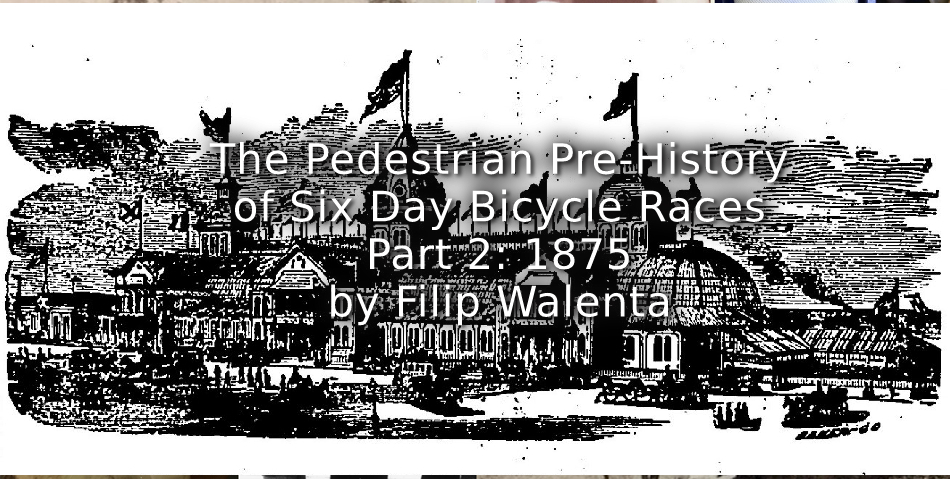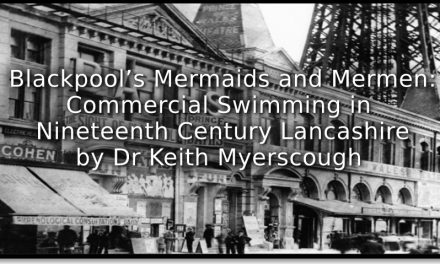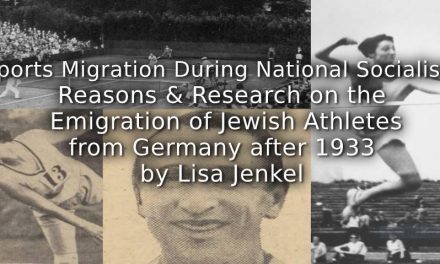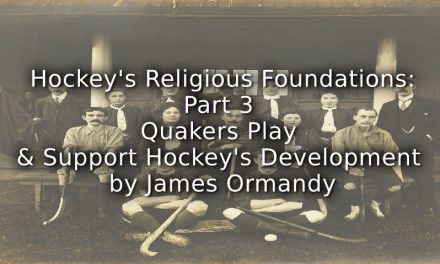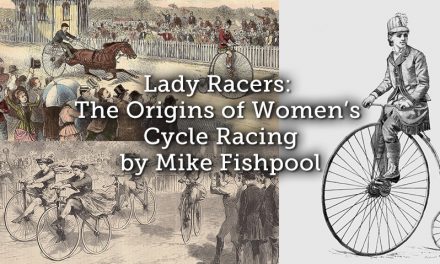To read Part 1 of this series click HERE
Introduction.
The first part of this sequel story mentions that 1874 was the year of the emergence of six day pedestrian races in the Northeastern United States. The twenty-four-hours and six-day race concepts were adopted as the standards of long-distance walking.[1] However, in 1875 the pedestrian competitions gradually changed. The six-day milestone was achieved, and it was commonly believed that the edge of physical capability was reached. Apart from a small group of athletes it was widely regarded as nearly impossible to break the distance record. Also the popularity in the press threatened to decrease because the year before a lot of attention was paid to the several attempts that were made nearly every month. In order to keep attracting the interest of the press, the big audience and the gambling industry, the time trial concept of endurance pedestrianism was gradually abandoned while another competition format was introduced: a six-day race with two or more pedestrians.
Weston vs Judd from 1 till 6 March 1875.
In February 1875 Edward Payson Weston was challenged by professor Judd for a six-day race in P.T. Barnum’s Hippodrome. Weston accepted after receiving a provocative letter Barnum had written where he says that “… considerable doubt appears to be entertained as your recent performance at the rink in Newark, and many would like to convince themselves of the ability of a human being to perform such a task”. A purse of five thousand dollars offered by the managers of the hippodrome was promised to the winner, and an additional purse of two thousand five hundred dollars if he also walked one hundred and fifteen miles within the first twenty four hours and five hundred miles in six consecutive days.[2] In the agreement signed by both the athletes more specific information concerning the rules of engagement was mentioned such as: the race was a fair heel-and-toe walk and Weston, feeling confident of scoring the largest distance, allowed Judd an advantage of thirty five miles.[3] To avoid any kind of discussion or confusion a double track was built, one for each of the athletes.[4] The members of the New York Athletic Club, the New York Caledonian Club, the New Jersey Athletic Association and other clubs were asked to act as judges.[5]
By Wednesday night Judd was already overtaken by Weston, who ended the day with a total distance of two hundred and fifty miles while Judd had walked only two hundred miles.[6] On Thursday afternoon Judd had to abandon the race due to sore feet so the five thousand dollar wage was easily won by Weston. But in order not to disappoint the spectators Judd’s place was taken by Edward Mullen with the credit to continue the race at the distance where Judd had stopped. Mullen also gave up after a walk of eighty nine miles with a blistered foot on Friday evening and was replaced by George B. Coyle.[7] Weston finally completed his six-day race on Saturday night after a walk of four hundred and thirty one miles.[8]

Edward Payson Weston on the front page of The Illustrated Sporting and Dramatic News.[9]
On March 10, 1875 Edward Payson Weston started another six day contest in the American Institute Hall. He intended to walk five hundred and fifteen miles in six consecutive days, among which one hundred and eighteen miles in twenty four hours, one hundred and twenty miles in twenty five hours and two hundred miles in forty eight hours.[10]
Although Weston was well prepared and in excellent shape, already after four hours of walking during the early morning of the first day he had to interrupt his effort by a severe strain on one of his hips and had to be carried to his room. He was given soothing medication and after five hours of rest he returned to the track and started a second twenty-four-hour record attempt.[11] On Tuesday morning Weston broke Daniel O’Leary’s recent record and walked one hundred and seventeen miles in twenty four hours, and won the second contest by walking one hundred and twenty miles in seven minutes less than twenty five hours.[12] On Wednesday he lost a lot of time due to the inflammation of several blisters on his feet, giving him a lot of agony.[13] After the nursing of his injuries he continued the endeavor and felt in excellent condition but was never able to catch up the lost time. Weston had walked two great performances but failed in the two hundred miles and the six-day race.[14] At 11:15 PM at Saturday night he concluded his performance after 375 miles, had his feet taking care of and immediately went to bed.[15]
Daniel O’Leary in the West Side Rink (Chicago) from 16 till 22 May 1875
After several successful one hundred mile walks in 1874, Daniel O’Leary commenced his first five hundred mile contest in one hundred and fifty six hours or six and one-half days. Several prominent gentlemen had confirmed to act as judges or referees among which Major Colvin, a few officials of the State of Illinois, judges and advocates, and army officers.[16] The start was planned at three o’clock in the afternoon on Sunday, May 16th 1875 in the West Side (Skating) Rink at the corner of Randolph and Ada Streets in Chicago. Before organizing the event O’Leary and his friends had to restore the flooring which they found in a terrible state of water and mud. The floor had to be covered by large amounts of sawdust and wood shavings, delaying the start by one and half an hour.[17] O’Leary finally commenced at 04:30 PM and after a staggering pace he covered his first fifty miles in eight hours and fifty six minutes, and passed the one hundred milestone in twenty three hours and one minute. During the first days of the week he progressed like a locomotive. On Monday and on Tuesday he walked one hundred miles. On Wednesday he slowed down his pace and took some more rest but still was thirteen hours ahead of the schedule.[18] And although the following days he suffered from a blistered heel, an injury that was caused during a previous walking feat by wearing a pair of undersized shoes, he continued his effort in an excellent condition.[19] Under the attendance of an exited crowd of five thousand spectators that had to be controlled by the police at times, O’Leary finished his walk on Sunday morning at 01:33 AM, nearly three hours sooner than the time allotted.[20] Next to his five hundred mile contest he succeeded in walking fifty miles within nine consecutive hours and two hundred miles in less than fifty hours. O’Leary was widely celebrated and offered several presents by enthousiastic fans and sponsors, among which a purse of one thousand dollars.[21]

Front cover of the book ‘Biographical Sketch of Daniel O’Leary, Champion Pedestrian of the World’.[22]
The two last days of his previous failed six-day contest Edward Payson Weston only walked short distances. He knew he could not reach his goal, so already before the conclusion of the race he probably had decided to start another trial immediately in the following week. As the twenty-four-hour record and other side issues were already conquered, this time Weston only wanted to focus on breaking the six-day record.[23] After a short night rest he got up around four o’clock on Sunday morning and went to the track for a recuperation walk of a couple of hours. Then he had his feed taken care of, took a hearty meal and returned straight to bed until late evening. On Monday morning at twenty five minutes past midnight Weston appeared on the track and started fresh and determined his second six-day attempt in two weeks time.[24] The first three days he progressed smoothly and his performance attracted a large number of people who wanted to witness his superhuman effort. But on Thursday morning the incredible load of nine days of (nearly continuous) long endurance walking had enormous repercussions upon his constitution. After waking up at four o’clock he complained of severe pain and stiffness in his right leg and could not walk comfortably. Weston had to be taken back to his room for several hours and due to the continued swelling of his ankle he was finally compelled to give up his attempt on Friday noon.[25]
It was quite a busy week for long distance pedestrianism, because several other feats started on Monday the 17th of May. At twelve o’clock a nonstop walking match until one cries “enough” was organized in the Comique Theatre, 514 Broadway, Manhattan, between the American champion Harry Brooks and Prof. George Carlyle for the purse of five hundred dollar and the Championship.[26] Brooks outwalked Carlyle during the course of the week and was still continuing on Friday as the general protest against such ventures grew by the day.[27]
And the pedestrian William H. Dutcher was announced to walk eight hundred miles in twelve days at Hyde Park, also starting on Monday the 17th of May. He alleged that during the feat he would carry a one pound dumbbell in each hand for fifty miles, walk nonstop for thirty eight hours without sleep and twenty five hours without food, and to wear a pair of shoes weighing ten pounds for twenty five miles. But as further information was not found the feat probably was never commenced.[28]
Dutcher’s fraude in North Adams (Springfield) from 12 till 17 July 1875
However, in July 1875 the twenty three years old William H. Dutcher commenced his first six-day contest in the Martin’s Hall in North Adams, Massachusetts.[29] On Saturday July the 17th he cleared the job with more than half an hour to spare and was, after Weston, the second person in history who could accomplish the five hundred miles task.[30] But a few weeks later it turned out that Dutcher’s performance was based on a big fraud. Apparently the timekeepers were bought off to record extra miles, even while he was actually sleeping.[31] It was not the first time that he was caught committing fraudulent acts. William Dutcher was an obscure man who, already at the age of twenty was accused for bigamy and sentenced to three years of hard labor in the Albany Penitentiary.[32] Nevertheless being a fraud, he managed to continue walking on a professional basis.
In the same week W. H. Craft of Albany succeeded in walking three hundred miles in less than one hundred hours in the park of Schenectady, New York.[33] In September he had plans for a six-day race in New York, but completed on Saturday the 2nd of October an astonishing eight hundred miles walk in fourteen days in Schenectady.[34]
(Chicago) from 25 till 30 October 1875
According to the local press the unknown Daniel Healey was supposed to walk five hundred miles in 148 hours starting on Monday, October 25, in the Exposition Building or the West Side Rink in Chicago.[35] As no further articles can be found the event probably did not start. But strangely his name did get in the newspapers in the same week for totally different reasons. On Tuesday evening Healey got involved in a murder case in a groggery in West Lake Street where he worked as a barkeeper.[36] Three days later he was arrested by the police and locked up in prison for further investigation as a prime witness. According to the police officers during his arrest Healey was seeing snakes, and reacted very wild and aggressively. Four policemen were needed to hold him and put him behind bars.[37] During the course of Friday night Daniel Healey died in his cell. The coroner concluded that he was suffering from a delirium and died from a liquor overdose. Whether the walkist and the barkeeper were one and the same person, could not be determined in the articles.[38]
Weston vs O’Leary from 15 till 20 November 1875
At the end of December 1874 Daniel O’Leary had congratulated Edward Payton Weston for his successful six-day contest two weeks before in a written article in The New York Herald. He also used the opportunity to challenge him for a walking match of any distance from twenty five to five hundred miles, at any place for any sum.[39] And in August The Chicago Daily Tribune reported that a stock company was founded to raise funds for an international pedestrian tournament in New York in October. Several important contests would be organized, among which a fifty and a one hundred mile walk, and a six-day race. A prize pool of two thousand dollars would be raised of which one thousand dollars would be allocated to the winner of the six days. The organization hoped to get the top of the pedestrian world at the start of the event -including O’Leary and Weston- but unfortunately the initiatives were never concreted.[40]
On November 1, 1875 Weston finally accepted the proposition of a committee of about one hundred citizens of Chicago to face O’Leary in a six-day match for a purse of five thousand dollars and the world championship title. As a large number of spectators was expected to witness the match the Inter-State Industrial Exposition Building was chosen as the battle field for the contest.[41] The Exposition Building was the largest venue in Chicago, erected in 1873 after the Great Fire two years before, and considered as the largest building in the United States.

The Inter-State Exposition Building, Chicago (Illinois).[42]
Announced as ‘The Great Walking Match’ both the athletes appeared at the Exposition Building precisely at midnight in excellent condition and spirits. After a short speech by mayor Marvin Doolittle Colvin the race was started on Monday morning at 00:08 AM.[45]
From the start O’Leary took the lead, increased it day by day and would never be overtaken by Weston. To ringing applause of thousands spectators, on Saturday evening at 10:21 PM he reached his five hundred mile goal, while Weston had walked four hundred and fifty one miles.[46] O’Leary was offered a basket of flowers by his wife and a gold metal as the new pedestrian champion of the world.
In his own defense for his defeat Weston argued that he did not get enough rest the day before the race and consequently was too tired to walk one hundred miles on the first day, and that the fumes of the charcoal of a peanut dealer troubled him in such a way he could not get asleep during the week.[47] Disappointed he took his family in December to the UK where he (re)introduced the six day pedestrian races.
In a wider historical perspective the six-day race between Weston and O’Leary was much more than a walking match and symbolic in many aspects.
Weston liked to present himself as a conservative native American Yankee and a smartly dressed dandy, although before his professional sports career he was just a door-to-door book salesman with a circus background. Otherwise O’Leary, who was seven years younger than Weston, represented the young progressive working class man and the in general not well-liked Irish immigrant. The Irish immigrants were held responsible for a lot of structural problems in the American society, among which the Great Chicago Fire in October 1871. According to the most popular tale, the cow of the Irish immigrant family O’Leary -not related to Daniel O’Leary- had knocked over a lantern that started the fire causing the destruction of more than three square miles and approximately three hundred casualties. However, the real reason for the inferno must be sought in the long hot and dry summer two months before. Anyway, Matthew Algeo certainly has a point when he argues that O’Leary’s victory was a blessing for the integration and acceptance of the Irish community in Chicago.[48]
Officially sixteen thousand dollars were received by the sale of admission tickets during the Weston-O’Leary race. As the entrance fee was set at fifty cents per person, at least thirty two thousand spectators had witnessed the race in the Exposition Building.[49] According to Matthew Algeo the urban industrialization had a direct impact upon the increasing leisure time of the working class, and that the popularity of (long endurance) pedestrianism exposed a great vacuum in the world of recreation. He argues that entertainment was too expensive for the common man, but comparing the entrance fees of the pedestrian races with variety shows in theatres in New York and Chicago during the same period indicate that there was no significant difference.[50] The reason for the popularity of long endurance walking feats was probably a bit more complicated and offers food for thought for the study of the emergence of spectator sports.
Conclusion
As mentioned in the introduction time trial walks became of less importance while races with two or more competitors gained popularity. The reason for the increasing attention is probably due to the fact that a race with several competitors added an extra dimension to the long-distance pedestrian feats. In a time trial race there is just one identity, the athlete, and two combined objectives: a desired distance in a predetermined time period. In races with multiple participants there is mostly just one major objective, covering a certain distance in the shortest time or completing the longest distance in a predetermined time period. The extra dimension is provided by the presence of at least two identities. The athletes do not only compete to cross the finish line first, but also race against each other. Consequently a new sports related aspect gets involved: tactics. This made the pedestrian races more complicated and also more interesting as a spectator sport because several interpersonal competitions took place at the same time within the event. It created more excitement for the spectators who could become personally involved by identifying themselves with (one or more of) the competitors, experience the thrill of the competition, discuss the race with other fanatics and become part of the sports community. It also provided more opportunities for the press to analyze the continuation of the race, the participants could be interviewed, and their physical abilities and tactical skills examined and compared. And of course such races provided additional options to the gambling industry that, as a consequence also could profit from the popularity of the multi-participants concept.
In short, the new race concept brought endurance pedestrianism to a next level with a mix of several aspects of sports and entertainment.
Article 2022 @ Filip Walenta
References
[1] Walenta, Filip, The Pedestrian Pre-History of Six Day Bicycle Races (Part 1: 1874), Playing Pasts. The Online Magazine for Sport & Leisure History, Februari 21, 2022.
<https://www.playingpasts.co.uk/articles/archival-research/the-pedestrian-prehistory-of-six-day-bicycle-races-part-1-1874/> (Accessed: May 19, 2022).
[2] Commercial Advertiser., February 18, 1875, 2.
[3] The New York Herald, February 28, 1875, 6.
[4] The Chicago Daily Tribune., March 7, 1875, 5.
[5] The New York Herald, February 28, 1875, 6.
[6] The Brewster Standard, March 5, 1875, 3.
[7] Geneva Courier., March 10, 1875, 2.
[8] The Sun., March 8, 1875, 1.
[9] The Illustrated Sporting and Dramatic News, February 19, 1876, 1.
[10] The Newark Courier., May 6, 1875, 3.
[11] The Sun., May 11, 1875, 1.
[12] The Sun., May 12, 1875, 1.
[13] The New York Herald, May 14, 1875, 3.
[14] The New York Herald, May 14, 1875, 3.
[15] The New York Herald, May 17, 1875, 7.
[16] The Chicago Daily Tribune., May 16, 1875, 14.
[17] The Chicago Daily Tribune., May 17, 1875, 2.
[18] The Chicago Daily Tribune., May 20, 1875, 5.
[19] The Chicago Daily Tribune., May 21, 1875, 5.
[20] The Chicago Daily Tribune., May 23, 1875, 13.
[21] Watertown Daily Times., May 25, 1875, 2.
[22] Tansey, John E., Biographical Sketch of Daniel O’Leary, Champion Pedestrian of the World: Together with a Full Account of All His Great Walks in the Past (Chicago, 1878).
[23] The New York Herald, May 16, 1875, 12.
[24] The New York Herald, May 17, 1875, 7.
[25] New York Tribune, May 22, 1875, 5.
[26] National Republican., May 17, 1875, 4.
[27] The Evening Star., May 22, 1875, 4.
[28] Watertown Daily Times., May 10, 1875, 2.
[29] The Chicago Daily Tribune., July 18, 1875, 12.
[30] The Catskill Recorder., July 23, 1875, 3.
[31] Crocket, Davy, ’97: Six-Day Race Part 5: Daniel O’Leary (1875)’, Ultrarunning History. Podcast and Stories, January 9, 2022.
<https://ultrarunninghistory.com/daniel-oleary/> (Accessed: May 7, 2022).
[32] The New York Herald, December 7, 1870, 5.
[33] The Chicago Daily Tribune., July 15, 1875, 5.
[34] Ibid; Brooklyn Daily Eagle., October 4, 1875, 4; The Evening Post., October 4, 1875, 4.
[35] The Chicago Daily Tribune., October 24, 1875, 12.
[36] The Chicago Daily Tribune., October 17, 1875, 8.
[37] The Chicago Daily Tribune., October 30, 1875, 14.
[38] The Chicago Daily Tribune., October 31, 1875, 16.
[39] The New York Herald, January 1, 1875.
[40] The Chicago Daily Tribune., August 17, 1875, 5.
[41] The New York Herald, November 1, 1875, 3.
[42] The Western Rural, July 27, 1878, 1.
[43] The Chicago Daily Tribune., October 15, 1875, 15.
[44] The Chicago Daily Tribune., October 17, 1875, 13.
[45] The Chicago Daily Tribune., November 15, 1875, 8.
[46] The Milford Times., November 17, 1875, 4.
[47] The Dallas Daily Herald, November 25, 1875, 2.
[48] Algeo, Matthew, Pedestrianism. When Watching People Walk Was America’s Favorite Spectator Sport, Chicago, 2014, 41.
[49] The Western Rural, November 27, 1875, 4.
[50] Algeo, Matthew, Pedestrianism. When Watching People Walk Was America’s Favorite Spectator Sport, Chicago, 2014, 41-42.
Other resources
Library of Congress. < https://www.loc.gov/newspapers/> (Accessed: April 25, 2022).
NYS Historic Newspapers. < https://nyshistoricnewspapers.org//> (Accessed: April 25, 2022).

